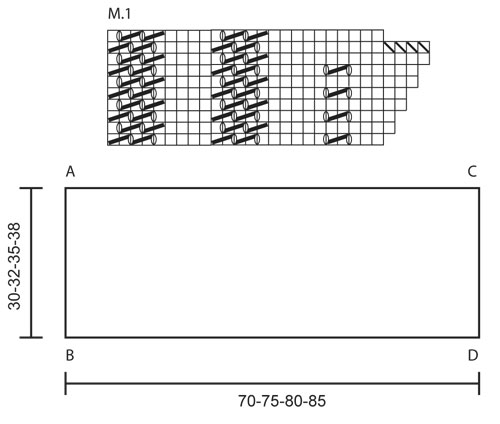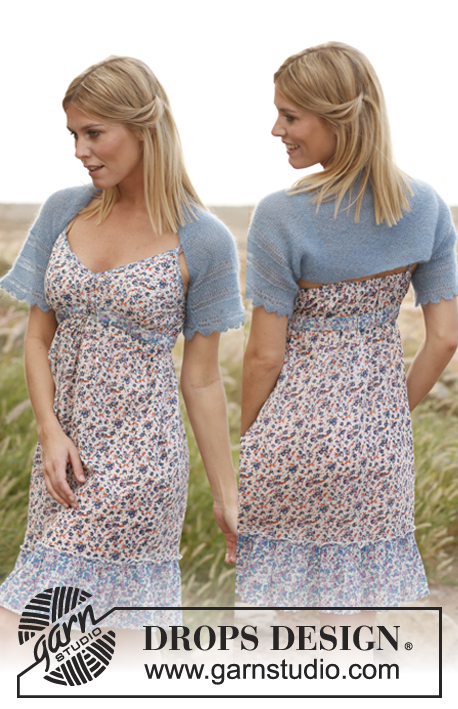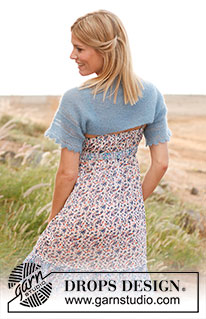Comments / Questions (18)
![]() Paola wrote:
Paola wrote:
Dopo il primo ferro si legge di fare così primo f. nel diagramma M.1 (= 24 m.), lavorare 92-102-112-122 m. a dir. (cioè le m. tra i segnapunti) e lavorare il 2° f. del diagramma M.1 sulle ultime 25 m..... Questa ultima parte cioè il 2 ferro del diagramma M1 va lavorato leggendo lo schema da six a dx? Per fare combaciare il bordo a smerlo della manica?
25.05.2020 - 19:11DROPS Design answered:
Buongiorno Paola. Sì è corretto, lavora il diagramma in modo che lo smerlo sia all'esterno. Buon lavoro!
26.05.2020 - 12:13
![]() Ingeborg Gruber wrote:
Ingeborg Gruber wrote:
Zuerst meinen allerbesten Dank für Ihre vielen schönen Anleitungen. Ich habe 2 Boleros (Akropolis und Mette) mit Ihrer Baby Merino-Wolle gestrickt, da fand ich die Strickrichtung beschrieben. Jedoch in manch anderen Shrug oder Bolero-Anleitungen rätsle ich, ob von der Seite her oder von unten nach oben oder umgekehrt gestrickt werden soll. Ein Pfeil in der Zeichnung wäre hilfreich - DANKE!
18.02.2019 - 18:09DROPS Design answered:
Liebe Frau Gruber, die Strickrichtung benutzen wir mehr jetzt in den Maßszkizzen. Dieses Modell wird von unten nach oben gestrickt - das Diagram M.1 wird auf beiden Seiten gestrickt (= Ärmelkante). Viel Spaß beim stricken!
19.02.2019 - 09:07
![]() Fillet Maryse wrote:
Fillet Maryse wrote:
In patroon 136-29 voorlaatste rij van het telpatroon moet je 4steken afkanten moet je die telkens herhalen of wanneer moet je die afkanten ik snap het niet echt
12.12.2016 - 15:43DROPS Design answered:
Hoi Fillet. Je herhaalt steeds het telpatroon M.1. Door de omslagen meerder je in de eerste 8 nld zodat je aan het begin van de 9e nld 28 st op de nld hebt. In deze nld kant je dan de eerste 4 st af = en je hebt 24 st weer op de nld. Begin opnieuw met het telpatroon.
13.12.2016 - 12:06
![]() Rosemary wrote:
Rosemary wrote:
Is it possible to knit this pattern in garter stitch all over. Will I have enough yarn specified in the pattern for this? Without help I cannot follow the instructions. Thank you
23.01.2016 - 17:18DROPS Design answered:
Dear Rosemary, altering a pattern can always influence the amount of required yarn - remember you can always get personnal help from your DROPS store - see here for Italy. Happy knitting!
25.01.2016 - 11:37
![]() Rosemary wrote:
Rosemary wrote:
Hi. I am also having a similar problem understanding the instructions as Trish Hopkins 25.05.2014 kl. 21:26: I have tried 4 times. Please can you help
23.01.2016 - 17:14DROPS Design answered:
Dear Rosemary, On first row with pattern work: 1st row in M.1 ( = 24 sts) and work remaining sts on row. On next row, work 1st row in M.1 (= 24 sts) on the first sts on needle, then work 92-122 sts (see size) and work 2nd row in M.1 over the last sts on needle. Turn, work 3rd row in M.1 over the first sts and the 2nd row in M.1 over the last sts and so on. Happy knitting!
25.01.2016 - 14:04
![]() Trish Hopkins wrote:
Trish Hopkins wrote:
Can you write out the chart for me, please? Not the symbols, but which rows at beginning/end. For example: seat w row 7, knit 112,follow row 6; turn; k tie 7, knit 112, k row 8; turn. I find your instructions confusing
25.05.2014 - 21:26DROPS Design answered:
Dear Mrs Hopkins, start reading diagram at the bottom corner on the right side, and start rows reading from the right towards the left, end rows reading pattern from the left towards the right. Happy knitting!
26.05.2014 - 09:59
![]() Charlotte wrote:
Charlotte wrote:
Hej på den pind hvor jeg skal starte med at strikke 3 pind i mønster og så retmasker og slutte med anden pind i mønsteret, er det rigtigt og hvad skal jeg så fortsætte med ? 4 pind først så retmasker og slutte med 3 pind??
12.05.2014 - 22:19DROPS Design answered:
Hej Charlotte. Ja, det er korrekt. Du er hele tiden 1 pind "bagud" i mönstret i den anden side af arbejdet.
13.05.2014 - 16:11
![]() Maria wrote:
Maria wrote:
Ich bin mit der Aussage "Faden abreissen" etwas unsicher - was soll das bedeuten? Strickt man nun mit einem Faden oder mit zwei doppelt? Was bringt das Anschlagen der Maschen mit 2 Fäden?
21.08.2013 - 21:39DROPS Design answered:
Liebe Maria, das war auf Deutsch etwas unglücklich formuliert, wir haben das nun überarbeitet: der eine Faden wird abgeschnitten und es wird mit nur 1 Faden weitergstrickt. Lediglich die Anschlag- und Abkettkante wird mit doppeltem Faden gearbeitet, damit sie nicht zu fest wird.
22.08.2013 - 08:11
![]() Samanta wrote:
Samanta wrote:
Ma quando le istruzioni dicono di lavorare il 1 ferro del diagramma m1 significa che devo partire dall'ultimo rigo da destra verso sinistra?
26.07.2012 - 00:02DROPS Design answered:
Si inizia sempre in basso a destra e si lavora verso sinistra. Buon lavoro!
27.07.2012 - 16:46
![]() Ria wrote:
Ria wrote:
Ik snap niets van dit patroon en met mij mijn vriendinnen niet. Moet er gemeerderd worden?
12.06.2012 - 21:52DROPS Design answered:
Bij het breien van M.1 aan de zijkanten komen er automatisch meer steken bij (bekijk de teltekening). Er is in elke 2e nld een extra omslag. In de tweede laatste nld van de teltekening kant u deze extra st weer af.
13.06.2012 - 10:19
Morning Dew#morningdewbolero |
|||||||||||||
 |
 |
||||||||||||
Knitted DROPS small bolero in garter st with lace pattern in ”Kid-Silk”. Size: XS - XXXL.
DROPS 136-29 |
|||||||||||||
|
PATTERN: See diagram M.1. No of sts in diagram M.1 will vary from 24 to 28. -------------------------------------------------------- BOLERO: There is no difference between RS and WS, the piece is the same on both sides. Start therefore every row as if it is worked from RS. Cast on 140-150-160-170 sts on needle size 3.5 mm / US 4 with 2 strands Kid-Silk. Remove one strand and K 1 row over all sts. Insert a marker after 24 sts in from each side (= 92-102-112-122 sts between markers). Work next row as follows: First row in diagram M.1 (= 24 sts), then K the rest of row. Turn and work as follows: First row in diagram M.1 (= 24 sts), K 92-102-112-122 sts (i.e. sts between markers) and work second row in diagram M.1 over the last 25 sts. Turn and work as follows: Third row in diagram M.1 over the first 25 sts, K the sts between markers and work second row in diagram M.1 over the last 25 sts. Continue to K the sts between markers on all rows and work diagram M.1 over sts in each side. REMEMBER THE GAUGE! When piece measures approx. 30-32-35-38 cm / 11¾"-12½"-13¾"-15" (stop after 1 full repetition of diagram M.1 in each side), K 1 row over all sts. Then LOOSELY bind off with 2 strands - it is very important that the bind off edge is not too tight. ASSEMBLY: Sew tog for sleeves as follows: Place A against B - see chart - and sew cast on edge against bind off edge – start at the outermost edge and sew approx. 10 cm / 4" in towards the middle (sew edge to edge to avoid a chunky seam). Sew the same way in the other side by placing C against D. |
|||||||||||||
Diagram explanations |
|||||||||||||
|
|||||||||||||

|
|||||||||||||
Have you finished this pattern?Tag your pictures with #dropspattern #morningdewbolero or submit them to the #dropsfan gallery. Do you need help with this pattern?You'll find 11 tutorial videos, a Comments/Questions area and more by visiting the pattern on garnstudio.com. © 1982-2025 DROPS Design A/S. We reserve all rights. This document, including all its sub-sections, has copyrights. Read more about what you can do with our patterns at the bottom of each pattern on our site. |
|||||||||||||


















































Post a comment to pattern DROPS 136-29
We would love to hear what you have to say about this pattern!
If you want to leave a question, please make sure you select the correct category in the form below, to speed up the answering process. Required fields are marked *.